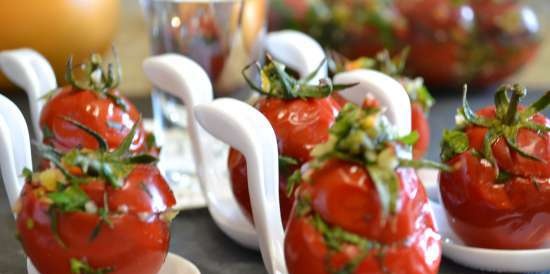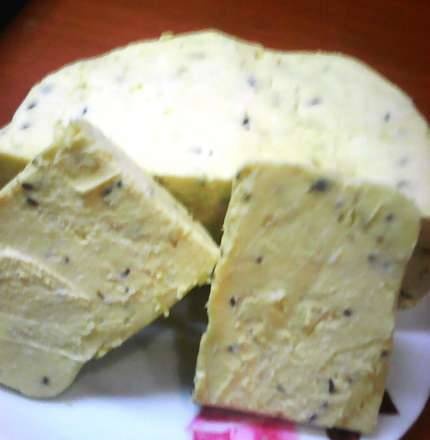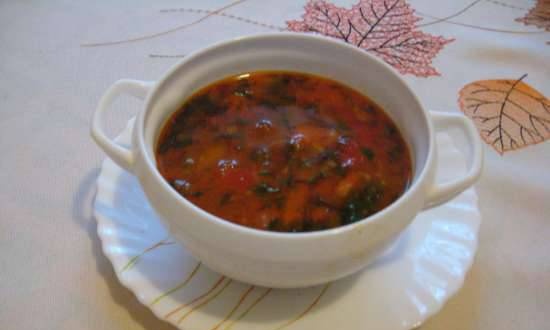|
 The most important figure in public catering is the cook. Where chefs do not work! They stand behind the stoves of factory kitchens and factory canteens, first-class restaurants and large branded cafes; they are boiled, fried and baked in kebabs, dumplings, cheburek, pancakes, cutlet, pies, pies, tea houses. The most important figure in public catering is the cook. Where chefs do not work! They stand behind the stoves of factory kitchens and factory canteens, first-class restaurants and large branded cafes; they are boiled, fried and baked in kebabs, dumplings, cheburek, pancakes, cutlet, pies, pies, tea houses.
Cooks work in hospitals and sanatoriums, at tourist bases and in pioneer camps, at distant polar winter quarters and on drifting ice floes! Putting on his shoulders a backpack in which there are cans of canned food, a primus stove, aluminum bowls and spoons, and heavy climbing boots on his feet, the cook climbs the icy mountain ledges, storming hard-to-reach peaks with friends in the detachment. He cooks in restaurant cars and autocafes, train stations, airports, and marinas.
The cook works in any conditions, often in the open air. He takes the kitchen to the collective farm field camp or to the place where military units are conducting exercises. Having finished distributing dinners, the cook polishes his utensils with the finest river sand, from which it begins to sparkle with a hot shine.
The cook "conjures" at the stove on the warship, in the kitchen called the galley. Here he is no longer called a cook, but a cook. His snow-white cap can be seen both on a luxury ocean liner making transatlantic voyages and on board the MRS, a small fishing seiner.
Food is primarily a physiological human need.
Yes, every nation has its own National cuisinereflecting the tastes and even the way of life of people: French - rabbit roast, beans, green peas and a lot of olive oil, golden, like the sun; Spanish - onion soup, beef in red, hot, like the air of Castile or Aragon, sauce with garlic and cayenne pepper; German - sausages with stewed sauerkraut, good quality pork schnitzels, beer with a white head of foam over a mug; English - oozing roast beef, oatmeal, pudding and strong, dark, cold tea; Dutch - onion, fried in a pan, three-layer sandwiches (fried eggs, bacon, ham), cheese and herringwhich is sold right on the streets. Passers-by come up, buy it and eat it right there. You can often see such a scene. A fashionably dressed girl stands near the tray and eats salty or pickled herring, gently holding it by the tip of the tail with two fingers.
Czech dumplings, Romanian hominy, polish dumplings, Bulgarian lecho, Italian spaghetti and risotto - each of these dishes is central to the national table. Many other peoples also liked them.
Recently, such specific dishes as kallia yehuni - lamb with spices, chinky curry - a sauce made from vegetables with spices and other products of Indian cuisine - have begun to gain popularity in Europe.
Our domestic dishes have also taken on an international character. Russian rich cabbage soup is a golden lake with a huge piece of meat floating in it. Magnificent pies, pies and shanezhki. Pancakes the size of a good skillet. The famous Volga ear, lavish with a wonderful aroma. The original Siberian dish is dumplings. Ukrainian borscht, dumplings and dumplings in sour cream, the same ones that jumped into Gogol's Patsyuk's mouth. Fiery Georgian kharcho scorching with spices and delicious kebabs fried on flaming coals. Uzbek pilaf, which has twenty varieties, among which one of the first places is tavuk palov - pilaf with chicken. Estonian bread soups.Tatar dish belyasha, which combines dough and meat.
To get a closer look at the work of those who cook all these delicious things, let's visit the kitchen of a modern catering enterprise.
As you know, catering enterprises are different. There are first-class restaurants with rows of ceremoniously arranged tables covered with starched snow-white tablecloths, with glasses, wine glasses, ashtrays gleaming on them, with silent waiters gliding around the hall and imposing doormen in clothes embroidered with gold galloons standing at the entrance. There are cafes where people come to have a cup of coffee, a cake or some other specialty confectionery, and there are canteens - the most common type of catering establishment.
It is difficult for a modern person, especially an urban one, to do without a dining room. Workers and employees go to the canteen during lunchtime, many use it on weekends, during their holidays. Lunches are taken from the dining room or from the kitchen belonging to it.
All kinds of people dine in canteens. Even without sociological research, without statistics, one can determine who is here by the appearance of visitors.
The first, when the soups and borscht were just about to boil in huge cauldrons, and the girls at the distribution were not tired of the kitchen fuss, visitors from other cities usually come here. It is not difficult to recognize them by their heavy suitcases, by the huge packages that they leave in the wardrobe or take with them to the hall.
Then there are employees from nearby institutions. Standing at the checkout or at the pantry, they only have clear business conversations for them.
In the middle of the day, the saleswomen drop into the dining room in flocks. They sit at tables in satin and silk work coats with their sleeves rolled up for convenience.
In the evening, students come, bachelors, lonely, not bothering to cook at home, write. And only occasionally will a married couple come here at this time, tired of shopping for purchases and pretty hungry.
We are talking in this case about a public dining room, the so-called open type. But there are also canteens - and there are no less of them - factory, factory, institutional, school. There are diet canteens, dairy. Finally, there is such a form of public catering enterprises as kitchen factories. These are huge food factories that employ hundreds of people. Not only dinners are prepared here, but also semi-finished products.
Before the revolution, there were no canteens in such a concept as now. There were restaurants, kitchens. The word "cafe" was almost never used. Instead of "cafe" they said "coffee". A century earlier, everything was united by the concept of "tavern". Linguists believe that initially they did not say "tavern", but "feed" (derived from the words "feed", "feed").
Then the word "tavern" appeared. The tavern, as is evident from the etymology of the word itself, stood by the road. that is, the path. Newcomers received food here. They sat down at oak tables, and the owner put pewter plates and bowls in front of them, jugs with some kind of drink, and mugs. Smoked hams and sausages hung on hooks high above the ceiling of the visitors.
Lavish names were usually given to inns: "White Horse", "Red Lily", "At Four Lindens".
In the tavern, it was possible, if necessary, to shoe a horse, fix a wheel, purchase fodder, stock up on food for the road.
But we have gone too far into history. Let's go back to our days.
We no longer have dining rooms with wood-burning stoves. Today dining rooms are equipped with huge gas stoves with a solid smooth surface, without burners. Near them are igniters with thick elastic hoses. These hoses make the ignitors on the floor look like a resting snake. The igniters ignite the burners hidden inside the stoves.Directly above the slabs hang pipes through which water is supplied: cold and hot. Not far from the main, main stove there are smaller stoves with burners, such as those in the kitchen in your home. Gas boilers, steam ovens, and various other gadgets - all this makes the kitchen of a catering enterprise look like some kind of hardware, like a factory floor. However, this is the shop. The air is hot here, like in a foundry, and the flames are raging in the furnaces in the same way, throwing crimson reflections on people's faces. Thirty degrees of heat, forty, fifty ... In such conditions workers of the public catering enterprise work in the so-called hot shop.
Electricity plays an increasingly important role in the "energy balance" of modern kitchens. It is used by chefs for various purposes. In electric pans, deep-fried potatoes and cutlets are fried. A universal workshop electric drive with a set of accessories is used for a wide variety of operations - for preparing minced meat, shredding and cutting raw and boiled vegetables, whipping mashed potatoes. For distribution, the so-called electric stool is used: it keeps food hot in boilers removed from the stove.
Ice for cocktails is produced by ice makers. In the confectionery shop there are electric beaters, kneading machines, special cabinets in which various products are baked. Low-temperature counters are used for storing and selling ice cream.
And technical progress goes further and further. Nowadays, high-frequency currents and infrared rays are often used for cooking: they shorten the cooking time of food products, protect them from burning, and make them more juicy.
The science fiction writer who invented the "molecular cafe" has not strayed too far from reality. Nowadays, directors of catering establishments. you have to understand not only cooking, but also electricity. They often use words such as rheostat, inductor, transformer, magnetic field ...
And yet, how the dinner is cooked - good or bad - depends primarily on the person, on the cook, on his skill.
Many people think that the same chef cooks both the first and the second. In other words, a jack of all trades. But this is not the case. A canteen or a restaurant is a production, and, as in every production, there are also specialties here.
Cooks are divided into soup and cold dishes, gravy boats and pastries. Some work in a hot shop, others in a cold one. It's not an easy job for them. But the most difficult, perhaps, is the slab. He stands all day by a hot, blazing hot stove. Soup, he leaves for distribution, and the slab does not leave his post until the end of the shift. He is engaged in frying and stewing. His work requires special attention. A little distracted - and then one begins to burn, then another. Cutlets "sob", pieces of meat "mutter". They call for help: we are overcooking, we stop! The slab should have time to do everything on time: remove the pan, move it to the edge of the stove, or, conversely, put it in the very middle, where it is hottest.
The cold shop is closely related to the hot one, but these are completely different productions. Hot cook soups, hodgepodge, cutlets, roast... Cold makes meat and fish snacks, salads, vinaigrettes. Its products are sold primarily through buffets. In a cold workshop it is not so hot, even, one might say, cool compared to a hot one, although the pace of work there is such that the cooks are also often sweaty. Knives are loudly knocking here, slicing boiled meat, fish, beets, carrots, turning tight cabbage heads into noodles, into a pile of curls flowing with light juice ...
Both in each production and in the kitchen there is a specificity. Here they will say not “scald” but “blanch”, not “roll in flour or crushed bread”, but “bread”, not “fry”, but “brown”.
A mixture of raw eggs and milk is called a leison.Sixteen methods of cutting vegetables and root crops are known here: strips, cubes, cubes, circles, slices, wedges, squares, rings, stars, gears, scallops, barrels, nuts, balls, shavings, cylinders. Shaped cutting is called carburizing. Fish is made boiled, stewed, fried, stuffed, and cutlets - natural, breaded, minced. Frying is carried out in deep fat, that is, completely immersing products in oil, and in semi-deep fat. There are also other ways of preparing dishes - baking, stewing, frying in dough, etc.
Now let's see how the cook's working day goes. We will visit the most ordinary, ordinary "pechetochka". Well, at least in the one located on Fontannaya Street in the Smolninsky district of Leningrad. With one of the workers in this dining room, the cook, we will talk. However, let's give the floor to her:
- Yes, our dining room does not stand out in any way. Is that located in a busy place - next to the market. Therefore, we always have a lot of visitors.
I come to work early in the morning. I change into sanitary clothes, my desk, at which I will work, my hands. I have many responsibilities. The dining room opens at eight. At this time, people are not yet having lunch, but only having breakfast. Therefore, first of all I prepare dishes for the buffet: some kind of light snack, herring, jelly... I will make ten - fifteen portions of each dish, and see how much they are in demand. If they diverge well, I do more. Then I prepare salads, vinaigrettes for the branch of our canteen.
The lunch break begins at twelve o'clock - the hottest time. Visitors walk continuously. It is my responsibility to serve the distribution. I prepare sets for hodgepodge, cut meat into small pieces, chicken, sturgeon - everything that is needed for the first courses. And then again for the buffet: salad, herring, vinaigrette ... This continues for an hour or two. But then the main flow of visitors subsided. Now you need to think about tomorrow: prepare marinades, boil potatoes, vegetables.
Late evening. The dining room is closing. Finally there is an opportunity to take a breath. I go to the buffet, look at which dishes have remained unsold, and decide what needs to be destroyed (after all, we must release only the freshest to our visitors) and what can be recycled.
Well, now, it seems, really everything. A cleaning lady with a mop is already walking around the room. In the kitchen, all the burners are extinguished, the cleanly washed boilers are turned upside down and dried on the stove, which will cool down for a long time, at least two or three hours.
I take off my work clothes, clean myself up and go home. And tomorrow everything will start again.
At first glance, my work is monotonous, unattractive. In the kitchen it is sometimes carbonic, and drafts, and unpleasant odors, but I love my cooking profession. I willingly cook at home, and if I go on a visit, I definitely bring my own culinary product with me. It's nice when people eat what you have done, with your hands, and praise ...
From the above story, you can see how hard a cook's job is. Not everyone likes it and can do it. But every year the process of cooking becomes easier, the work of public catering enterprises is rationalized and improved.
The lunch you are served in the dining room is born the night before. The production manager (as before, the chef, or managerial), looking through the "Collection of recipes" and based on the availability of products in the pantry, draws up the menu for the next day. In the morning, having come to work, the cooks take the menu and, guided by it, begin to cook. The menu is the score against which the culinary symphony is played.
The Lensnabnarpit office supplies food to the catering company. The canteen director or production manager orders the necessary products by phone, and the food depots provide their delivery.Delivery is carried out according to the so-called ring method: one car delivers products to several canteens. Some products are delivered in semi-finished form. Cutlets, meatballs, langets, steaks, entrecotes come off the conveyors of food factories and culinary factories. The cook only needs to put the semi-finished products in the pan and make sure that nothing is burnt or overcooked.
Of course, it is good that the work of the chef is rationalized. This makes cooking easier. But, unfortunately, not all chefs realize that the transition to semi-finished products is one of the progressive ways of developing public catering. Since working with semi-finished products is a new, unusual business for some chefs, they believe that this de-fetters the cook's imagination, which is needed in cooking as well as in any art. There is a certain kitchen conservatism here.
However, the number of conservatives in public catering is decreasing every year. There are many more who put their whole soul into their work. And here I would like to tell you about the cook Irina Ivanovna Izotova.
This already middle-aged woman stood all her life at the stove, in the heat and in the draft, but not in some famous restaurant, “whether a cafe, not in a kitchen factory equipped with the latest culinary technology, but in more than modest canteens at schools. Her last place of work was vocational school number 23.
The canteens of educational institutions of labor reserves have one feature: students here receive free breakfasts, lunches, and in some places dinners. It is clear that children are not fed with pickles. A certain amount is allocated for the food of each student, and for this amount the cook must feed the children hearty and tasty. The task, frankly, is not an easy one.
It was here that Irina Ivanovna's art appeared. From the most ordinary products, including semi-finished products, she prepared excellent breakfasts, lunches and dinners for boys and girls, tried, as they say, from the heart.
Somehow she had to feed Vietnamese children who came to Leningrad to get a specialty. The young Vietnamese came to the dining room at seven in the morning. In order not to be late with breakfast, Irina Ivanovna often did not go home in the evenings, but spent the night right there in the dining room, in the director's office, where for this time she set up a narrow, not very comfortable sofa for herself.
Looking at the guys, Irina Ivanovna wondered what kind of food they loved. At first, the Vietnamese ate very little bread (unusual!), But give them rice all three times - for breakfast, lunch, and dinner. But gradually they got used to Russian food. "Thank you mom!" - every time, getting up from the table, the Vietnamese students thanked Irina Ivanovna. On holidays, she and all the employees of the canteen were handed greeting cards, flowers, and small gifts. And when leaving Leningrad to their homeland, they left the following record: "The fried potatoes you cooked are not inferior to our rice!" This praise was the best assessment of the skill of the cook Irina Ivanovna Izotova. To the story about Irina Ivanovna, it remains only to add that she was awarded a high government award - the Order of the October Revolution.
School meals are an important part of the cook's work. Preschool food for children is of the same importance, especially since it is necessary to cook in a special way for children. The cook of a kindergarten (nursery, kindergarten) should, like no one else, take into account the tastes and requirements of their little consumers, so that everything they eat is good for them.
Evdokia Fyodorovna Zarubina was once a cook in the dining room of the Murmansk trade port. During the war she trained for pilots, and in peacetime she devoted herself entirely to working in children's institutions in Leningrad. For the last ten years she has been working in kindergarten No. 100 in the Moscow region. The guys are well fed here! The kitchen of this kindergarten is well known.And “Aunt Dusya,” as the children call Evdokia Fedorovna, it is pleasant to hear when the baby, meeting his mother who came for him, joyfully says: “Mom, today they gave us pies - delicious, tasty!”
An interesting feature. Today, food preparation in catering enterprises is almost entirely in the hands of women. The overwhelming majority of chefs of all specialties are women. And there was a time when the question of the role of women in public catering was almost a subject of controversy.
In 1929, the Narpit magazine wrote:
“In FZU, the percentage of girls is extremely low, in evening cooking schools - the same thing, but meanwhile, it would seem that the profession of a cook is quite accessible for a woman, and a small practice of women working in public catering enterprises speaks for the fact that a woman is much more in place in this profession. "
Now, on the contrary, in the sphere of public catering, they state with some chagrin: “Few young men go to educational institutions and public catering establishments”.
Before the revolution, cooking was considered exclusively a male property. The same, incidentally, applied to the waiters. If a woman got to work in a restaurant, it was mainly for the role of a flower girl. With a basket of flowers or a tray on which there were bouquets, she went out into the hall and offered them to visitors.
A number of women ended up in barmaids. In addition, they could go to serve in pastry shops and coffee shops. There the staff consisted mainly of women.
But what is most curious is that the first cooking schools were organized for women. In France, at the beginning of this century, the Cordon-bleu school gained popularity. The culinary knowledge acquired by her pets was highly regarded. The school regularly participated in culinary exhibitions, and even had its own magazine.
Graduates of cookery schools received special certificates. According to these testimonies, women were entitled to work in the most first-class restaurants, but they were not hired there. They were hired at best as cooks in private houses. But a woman was reluctant to enter the "master's kitchen", even if she had a certificate of graduation from a cook's school. Aristocratic families preferred male cooks. Cooks were hired by officials, shopkeepers, teachers.
The woman took the leading role in the kitchen of public catering enterprises not so long ago - some thirty or forty years ago - and firmly established her rights to this. When the first citywide competition for young catering workers was held in Leningrad in 1967, the winners were chefs Lyubov Pereladova, Valentina Smirnova, confectioners Lyudmila Shishkina, Raisa Tirranen, Lyudmila Kulandina. And only one young man. What has been said about women, however, does not mean that there are no great male chefs in our time. For example, master chef Oleg Alexandrovich Babikov has been heading the kitchen of the Metropol restaurant since 1961. He is an excellent cook, an excellent organizer, and an excellent mentor. Such popular specialties as “Metropol” and “Mignon” fillets, Poleningrad roast, and “agratan” pike perch (fried and baked) are Babikov's contribution to the classic Russian cuisine. The "Novinka" cutlet (minced pork, without a roll, stuffed with chicken liver, fried with onions) could be called "Bab.ikovski cutlet".
Oleg Aleksandrovich is not only a skilled cook, but also a tireless innovator in the field of kitchen technology. He has created comfortable production tables for cooks, a refrigerated table for rolling puff pastry, a device for opening cans, all kinds of molds for jellies, tartlets (dough baskets for garnishes). His rationalization contribution in the ninth five-year period alone amounted to about seven thousand rubles in savings. O. A. Babikov's creative work was awarded the Order of the Red Banner of Labor.
Of course, not all chefs are like Irina Ivanovna Izotova or Oleg Alexandrovich Babikov.There are others. For them, diners are like a kind of hostile tribe, which usually appears in kitchen conversations under the word "they". This word is pronounced with indifference, and sometimes frank dislike is embedded in it. Grandfather “they” not only eat, drink, leaving behind heaps of dirty dishes on the tables, but also, as consumers, can make a comment, demand a book of complaints and write a far from flattering review in it. But what can you do if some of the catering workers do not deserve anything else!
Appetite, as the saying goes, comes with eating. But it may not appear if what you eat is tasteless, too salty or overcooked, made without a soul.
The younger generation of chefs adopts all the best in their work from their elders, tries to be sensitive and attentive to the consumer, and the consumer responds to this self-respect with mutual respect, especially when they see not a kulnnar-artisan, but a culinary-creator.
The fact that the young generation honorably supports the high brand of the Soviet culinary school is evidenced, in particular, by the first review of catering specialists from countries - members of the Council for Mutual Economic Assistance, held in October 1976 in Budapest. Each country was represented by three chefs, three pastry chefs and three waiters. The Soviet delegation included waiters from Tallinn, pastry chefs from Vilnius and cooks from Leningrad. Elena Denisova from the public catering plant of the production association "Svetlana", Leonid Beresnev from the restaurant of the Sovetskaya Hotel and Gennady Petrov from the "Metropol" demonstrated truly high cooking skills at the show.
Medvedev N.M. Country Cooking
|










